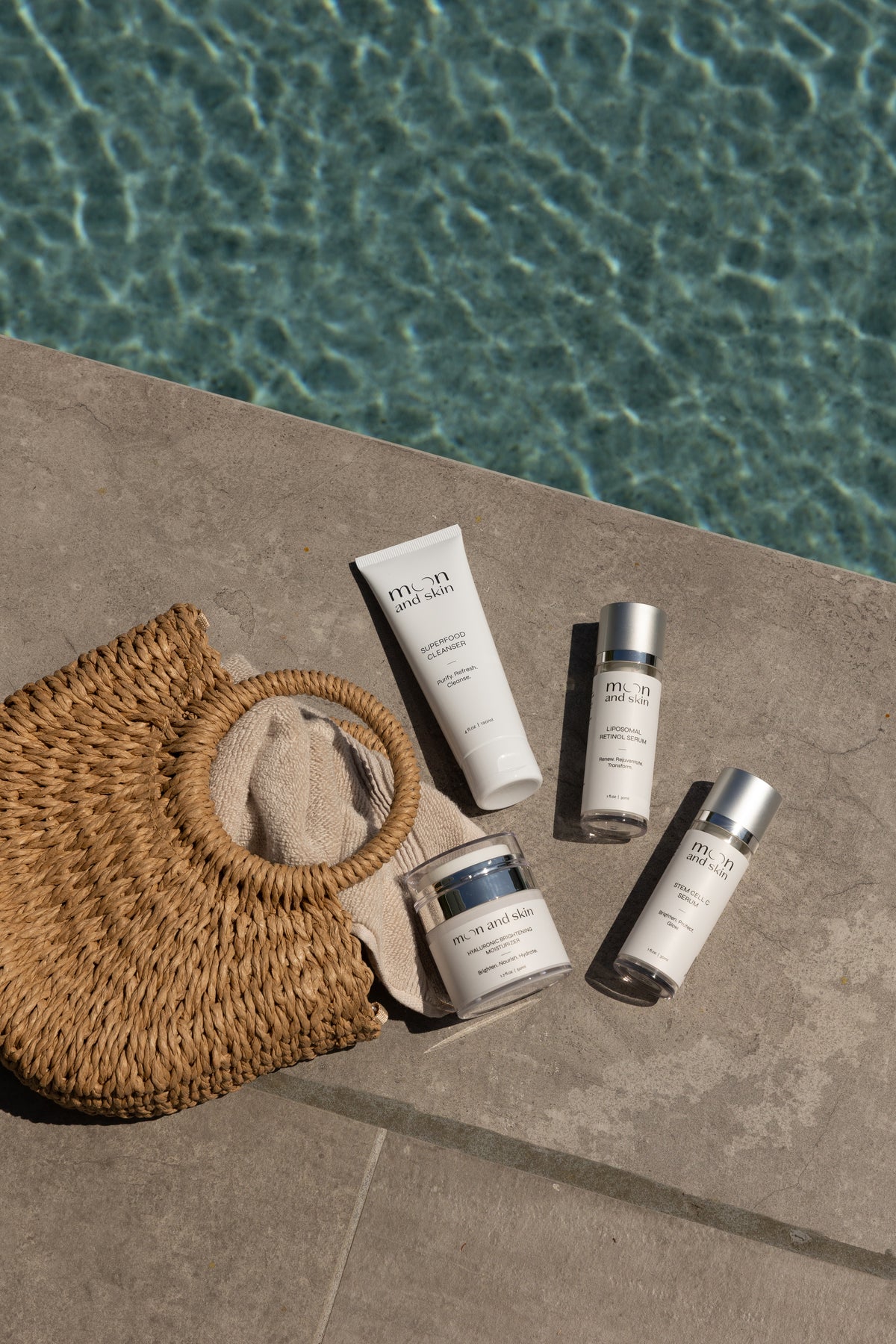सामग्री की तालिका
- परिचय
- उत्पति और निष्कर्षण प्रक्रियाएँ
- पोषण संबंधी प्रोफाइल: अंदर क्या है?
- त्वचा की देखभाल के लिए फायदे
- Grapeseed Oil और Castor Oil का उपयोग कैसे करें
- संभावित साइड इफेक्ट्स और विचार
- निष्कर्ष
- अक्सर पूछे जाने वाले प्रश्न
क्या आपने कभी सोचा है कि आपके द्वारा अपने स्किनकेयर रुटीन के लिए चुने गए तेल आपकी त्वचा के स्वास्थ्य को कैसे प्रभावित कर सकते हैं? प्राकृतिक तेलों की वृद्धि के साथ, Grapeseed Oil और Castor Oil लोकप्रिय विकल्प बन गए हैं। दोनों तेलों की पौष्टिक गुणों के लिए प्रशंसा की जाती है, लेकिन इनमें विशिष्ट विशेषताएँ हैं जो उन्हें विभिन्न त्वचा प्रकारों और समस्याओं के लिए उपयुक्त बनाती हैं। यह ब्लॉग पोस्ट Grapeseed Oil और Castor Oil की जटिलताओं में गहराई से जाएगी, उनके लाभ, उपयोग, और यह कैसे आपके अद्वितीय स्किनकेयर आवश्यकताओं के लिए सही चयन करें।
परिचय
कल्पना कीजिए कि आप एक अंगूर के बाग में चल रहे हैं, जहाँ सूर्य सुस्त, पके अंगूरों पर चमक रहा है। जब अंगूरों की कटाई की जाती है, तो बीज अक्सर फेंक दिए जाते हैं। लेकिन क्या आप जानते हैं कि ये बीज आपकी त्वचा के लिए अद्भुत संभावनाएँ रखते हैं? Grapeseed Oil, जो इन बीजों से निकाला जाता है, बहुत से लाभों के साथ आता है, जिससे यह स्किनकेयर में एक लोकप्रिय सामग्री बन जाता है। दूसरी ओर, Castor Oil, जो कास्टर्स से निकाला जाता है, विभिन्न संस्कृतियों में इसके उपचारात्मक गुणों के लिए सदियों से उपयोग में लाया जाता है।
इस पोस्ट में, हम Grapeseed Oil और Castor Oil के बीच के भिन्नताओं को उजागर करने का लक्ष्य रखते हैं, उनकी अनोखी विशेषताओं, लाभों, और अनुप्रयोगों पर ध्यान केंद्रित करेंगे। इस लेख के अंत तक, आपके पास यह स्पष्ट समझ होगी कि कौन सा तेल आपके स्किनकेयर रुटीन के लिए सबसे अच्छा फिट हो सकता है और इसे प्रभावी रूप से कैसे शामिल करें।
हम दोनों तेलों की उत्पत्ति और निष्कर्षण प्रक्रियाओं, उनके पोषण संबंधी प्रोफाइल, और स्किनकेयर में उनकी भूमिकाओं की खोज करेंगे। इसके अतिरिक्त, हम इन तेलों का उपयोग कैसे करें, संभावित साइड इफेक्ट्स पर सुझाव देंगे, और यह सुनिश्चित करने के लिए कुछ अक्सर पूछे जाने वाले प्रश्नों के उत्तर प्रदान करेंगे कि आपके पास जानकारी हो जो आपको एक सूचित निर्णय लेने में मदद करे।
उत्पति और निष्कर्षण प्रक्रियाएँ
Grapeseed Oil: वाइन बनाने का उप उत्पाद
Grapeseed Oil को अंगूरों के बीजों से निकाला जाता है, जो वाइन बनाने की प्रक्रिया का एक उप उत्पाद है। यह तेल "कोल्ड-प्रेसिंग" नामक विधि के माध्यम से प्राप्त किया जाता है, जहाँ बीजों को यांत्रिक रूप से दबाया जाता है ताकि बिना गर्मी या रासायनिक पदार्थों का उपयोग किए बिना तेल निकाला जा सके। यह विधि तेल के मूल्यवान पोषक तत्वों को बनाए रखती है, जिनमें ओमेगा-6 फैटी एसिड, विटामिन E, और एंटीऑक्सीडेंट शामिल हैं।
Grapeseed Oil को इसके हल्के बनावट और उच्च धूम्रपान बिंदु के लिए सराहा जाता है, जो इसे केवल स्किनकेयर के लिए नहीं, बल्कि खाना पकाने के लिए भी एक बहुपरकारी तेल बनाता है। इसका गैर-कॉमेडोजेनिक स्वभाव इसे उन लोगों के लिए उपयुक्त बनाता है जिनकी त्वचा oily या मुँहासे-प्रवण है।
Castor Oil: एक समय-सम्मानित उपाय
Castor Oil, Ricinus communis पौधे के बीजों से प्राप्त होता है, जिसे आमतौर पर कास्टर्स के रूप में जाना जाता है। निष्कर्षण प्रक्रिया में आम तौर पर बीजों को कोल्ड-प्रेसिंग के द्वारा दबाया जाता है, उसके बाद अशुद्धियों को हटाने के लिए परिष्कृत किया जाता है। Castor Oil का गाढ़ा स्थिरता होता है और यह राइसिनोलेइक एसिड में समृद्ध होता है, जो एक फैटी एसिड है जो उसके सूजन-रोधी और रोगाणुरोधी गुणों के लिए जाना जाता है।
ऐतिहासिक रूप से, Castor Oil का उपयोग विभिन्न उद्देश्यों के लिए किया जाता रहा है, जिनमें एक रेचक के रूप में, बालों की देखभाल में, और त्वचा के अनुप्रयोगों के लिए शामिल हैं। इसका भारी बनावट गहरी मॉइस्चराइजेशन की तलाश में रहने वाले लोगों के लिए लाभदायक हो सकता है, लेकिन यह सभी के लिए उपयुक्त नहीं हो सकता, खासकर मुँहासे से प्रभावित लोगों के लिए।
पोषण संबंधी प्रोफाइल: अंदर क्या है?
Grapeseed Oil पोषण का विश्लेषण
Grapeseed Oil लाभकारी तत्वों से भरा होता है, जिनमें शामिल हैं:
- ओमेगा-6 फैटी एसिड: त्वचा के स्वास्थ्य और हाइड्रेशन को बनाए रखने के लिए आवश्यक।
- विटामिन E: एक शक्तिशाली एंटीऑक्सिडेंट जो त्वचा को मुक्त कणों से होने वाले नुकसान से बचाता है।
- पॉलीफेनोल्स: ये एंटीऑक्सिडेंट सूजन को कम करने और त्वचा के रंग को सुधारने में मदद करते हैं।
Grapeseed Oil की हल्की प्रकृति इसे ऐसे लोगों के लिए उत्कृष्ट विकल्प बनाती है जो बिना चिपचिपापन के हाइड्रेशन की खोज में हैं।
Castor Oil पोषण का विश्लेषण
Castor Oil विभिन्न गुणों का एक अलग समूह प्रस्तुत करता है:
- राइसिनोलेइक एसिड: यह अद्वितीय फैटी एसिड सूजन-रोधी और रोगाणुरोधी लाभ प्रदान करता है, जिससे Castor Oil मुँहासे-प्रवण त्वचा के लिए एक लोकप्रिय विकल्प बनता है।
- फैटी एसिड: Castor Oil में ओलिक और लिनोलिक एसिड का मिश्रण होता है, जो त्वचा को मॉइस्चराइज और पोषण में मदद कर सकता है।
- विटामिन E: जैसे Grapeseed Oil में, Castor Oil में भी विटामिन E होता है, जो इसके एंटीऑक्सीडेंट लाभों में योगदान करता है।
हालाँकि Castor Oil अधिक गाढ़ा और भारी होता है, यह सूखी त्वचा के लिए गहरा पोषण या विशिष्ट क्षेत्रों, जैसे कि निशान या दाग के लिए लक्षित उपचार प्रदान कर सकता है।
त्वचा की देखभाल के लिए फायदे
Grapeseed Oil के लाभ
- हाइड्रेशन: Grapeseed Oil एक उत्कृष्ट मॉइस्चराइज़र है, जो त्वचा पर भारीपन महसूस किए बिना हाइड्रेशन को स्थिर करने में मदद करता है।
- एंटीऑक्सीडेंट सुरक्षा: इसका उच्च विटामिन E सामग्री ऑक्सीकृत तनाव से लड़ने में मदद करता है और महीन रेखाओं और झुर्रियों की उपस्थिति को कम कर सकता है।
- मुँहासे की रोकथाम: इसकी गैर-कॉमेडोजेनिक प्रकृति के कारण, Grapeseed Oil तेल उत्पादन को संतुलित करने में मदद करता है और clogged pores को रोक सकता है।
- त्वचा के रंग में सुधार: Grapeseed Oil में मौजूद एंटीऑक्सीडेंट त्वचा के रंग को समान बनाने और काले धब्बों की उपस्थिति को कम करने में मदद कर सकते हैं।
Castor Oil के लाभ
- गहरी मॉइस्चराइजेशन: Castor Oil की गाढ़ी स्थिरता तीव्र हाइड्रेशन प्रदान करती है, जो सूखी जगहों और अतिरिक्त देखभाल की आवश्यकता वाले क्षेत्रों के लिए आदर्श है।
- सूजन-रोधी गुण: राइसिनोलेइक एसिड जलन वाली त्वचा को शांत करने में मदद करता है और मुँहासे से संबंधित लालिमा और सूजन को कम कर सकता है।
- उपचार को बढ़ावा देता है: Castor Oil की ऊतकों की वृद्धि को बढ़ावा देने की क्षमता निशान और दाग के उपचार में मदद कर सकती है।
- बालों के लिए पोषण: जबकि यह लेख त्वचा पर ध्यान केंद्रित करता है, यह उल्लेखनीय है कि Castor Oil को अक्सर बालों की वृद्धि को बढ़ावा देने और खोपड़ी के स्वास्थ्य में सुधार के लिए उपयोग किया जाता है।
Grapeseed Oil और Castor Oil का उपयोग कैसे करें
अपने रुटीन में Grapeseed Oil को शामिल करना
- मॉइस्चराइज़र: एक साफ, नम त्वचा पर सीधे कुछ बूँदें Grapeseed Oil लगाएँ ताकि नमी बंद रह सके।
- मेकअप हटाने वाला: त्वचा पर मसाज करके और पानी से धोकर Grapeseed Oil का उपयोग एक हल्के मेकअप हटाने वाले के रूप में करें।
- फेशियल सीरम: Grapeseed Oil को आवश्यक तेलों या अन्य कैरियर तेलों के साथ मिलाकर एक व्यक्तिगत फेशियल सीरम बनाएं।
अपने रुटीन में Castor Oil को शामिल करना
- स्पॉट उपचार: लक्षित उपचार के लिए कॉटन स्वैब का उपयोग करके दाग या निशानों पर Castor Oil की एक छोटी मात्रा लगाएँ।
- मॉइस्चराइजिंग मास्क: सूखी जगहों के लिए एक पोषण मास्क बनाने के लिए Castor Oil को हल्के तेल, जैसे जोजोबा या Grapeseed Oil के साथ मिलाएँ।
- बालों का उपचार: स्कैल्प पर मालिश करके और कुछ घंटों के लिए छोड़कर Castor Oil का उपयोग एक बाल उपचार के रूप में करें, फिर धो लें।
संभावित साइड इफेक्ट्स और विचार
हालांकि दोनों तेल सामान्य रूप से अधिकांश त्वचा प्रकारों के लिए सुरक्षित होते हैं, संभावित साइड इफेक्ट्स पर विचार करना आवश्यक है:
- Grapeseed Oil: कभी-कभी कुछ व्यक्तियों को जलन या आलर्जी प्रतिक्रियाएँ हो सकती हैं। हमेशा व्यापक आवेदन से पहले पैच टेस्ट करना चाहिए।
- Castor Oil: इसके भारी बनावट के कारण, Castor Oil oily या मुँहासे-प्रवण त्वचा के लिए pores को clog कर सकता है। इसे सीमित रूप से उपयोग करना या हल्के तेलों के साथ मिलाना उचित है।
निष्कर्ष
Grapeseed Oil और Castor Oil के बीच के बहस में, चुनाव अंततः आपकी त्वचा के प्रकार और विशेष आवश्यकताओं पर निर्भर करता है। Grapeseed Oil उन लोगों के लिए एक अद्भुत विकल्प है जो हल्का हाइड्रेशन और एंटीऑक्सीडेंट सुरक्षा चाहते हैं, जबकि Castor Oil गहरी मॉइस्चराइजेशन और उपचारात्मक गुण प्रदान करता है।
Moon and Skin पर, हम आपकी त्वचा की देखभाल के महत्व को समझते हैं। हमारा मिशन आपको प्राकृतिक सामग्री और उनके लाभों के बारे में ज्ञान प्रदान करना है। जैसे ही आप तेलों की दुनिया की खोज करते हैं, याद रखें कि आपकी त्वचा भी चाँद के चरणों की तरह विकसित होती है—परिवर्तन को गले लगाते हुए और यह पता लगाते हुए कि आपके लिए सबसे अच्छा क्या है।
हम आपको हमारे “Glow List” में शामिल होने के लिए आमंत्रित करते हैं, जहाँ आपको विशेष छूट और हमारे आगामी उत्पादों पर अपडेट मिलेंगे। आज ही Moon and Skin पर साइन अप करें।
अक्सर पूछे जाने वाले प्रश्न
प्रश्न: क्या मैं Grapeseed Oil और Castor Oil को एक साथ उपयोग कर सकता हूँ?
उत्तर: हाँ, आप उनके लाभों को संयोजित करने के लिए Grapeseed Oil और Castor Oil को मिला सकते हैं। यह मिश्रण हाइड्रेशन प्रदान कर सकता है जबकि यह Castor Oil के पौष्टिक गुणों को बनाए रखते हुए।
प्रश्न: oily त्वचा के लिए कौन सा तेल बेहतर है?
उत्तर: Grapeseed Oil सामान्यतः oily त्वचा के लिए बेहतर होता है क्योंकि इसकी हल्की और गैर-कॉमेडोजेनिक प्रकृति होती है। Castor Oil oily त्वचा के लिए बहुत भारी हो सकता है।
प्रश्न: मुझे कितनी बार इन तेलों का उपयोग करना चाहिए?
उत्तर: आप Grapeseed Oil को दैनिक रूप से एक मॉइस्चराइज़र के रूप में उपयोग कर सकते हैं, जबकि Castor Oil का सर्वोत्तम उपयोग सप्ताह में कुछ बार या आवश्यकतानुसार लक्षित उपचार के लिए किया जाता है।
प्रश्न: क्या कोई ऐसे तेल हैं जिनसे मुझे बचना चाहिए अगर मेरी त्वचा संवेदनशील है?
उत्तर: यदि आपकी त्वचा संवेदनशील है, तो किसी भी नए उत्पाद का उपयोग करने से पहले पैच टेस्ट करना सलाह दी जाती है। Grapeseed और Castor Oil सामान्यतः सुरक्षित होते हैं, लेकिन व्यक्तिगत प्रतिक्रियाएँ भिन्न हो सकती हैं।
प्रश्न: क्या ये तेल मुँहासे के लिए मदद कर सकते हैं?
उत्तर: Grapeseed Oil की गैर-कॉमेडोजेनिक विशेषताएँ और Castor Oil के सूजन-रोधी प्रभाव दोनों ही मुँहासे-प्रवण त्वचा के लिए लाभकारी हो सकते हैं। हालाँकि, परिणाम व्यक्ति से व्यक्ति भिन्न हो सकते हैं।
Grapeseed Oil और Castor Oil के लाभों और गुणों को समझकर, आप अपने स्किनकेयर रुटीन के लिए सूचित विकल्प बना सकते हैं। स्वस्थ, रेशमी त्वचा के लिए प्राकृतिक उत्पादों की खोज में हमारे साथ इस यात्रा को अपनाएँ!







